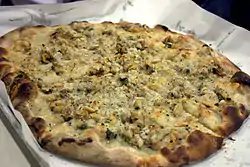New Haven-style pizza
New Haven-style pizza, locally known as apizza (/əˈbiːts(ə)/,[1][2] from Neapolitan ’a pizza (IPA: [ə ˈpit͡s(ə)]) "the pizza"), is a style of thin-crust, coal-fired Neapolitan pizza common in and around New Haven, Connecticut. It originated at the Frank Pepe Pizzeria Napoletana[3] and is now served in many other pizza restaurants in the area, most notably Sally's Apizza and Modern Apizza.[4] This geographically limited pizza style has been favorably referenced by national critics.[5][6][7]
 White clam pie from Pepe's in New Haven, Connecticut | |
| Alternative names | Apizza |
|---|---|
| Type | Pizza |
| Place of origin | United States |
| Region or state | New Haven, Connecticut |
| Created by | Frank Pepe Pizzeria Napoletana |
| Main ingredients | Pizza dough, tomato sauce, pecorino romano |
| Part of a series on |
| Pizza |
|---|
 |


Characteristics
In a New Haven-style pizzeria, a "plain" pizza is a crust, oregano, and tomato sauce with a little bit of grated pecorino romano cheese. A "plain" New Haven-style pizza may also be called a "tomato pie".[8] Mozzarella is considered to be a topping; a customer who wants it must ask for it.
Pepe invented the "white clam pie". Pepe's restaurant served littleneck clams on the half shell at the bar, which he later added to the pizza.[9][10] The white clam pie is a crust, olive oil, oregano, grated cheese, chopped garlic, and fresh littleneck clams.
What makes New Haven-style pizza distinct is its thin, oblong crust, characteristic charring, chewy texture, and limited use of melting cheeses. It tends to be drier and thinner than, but closely related to, traditional New York-style pizza. Both styles in turn are close descendants of the original Neapolitan style.
Cooking and serving methods
New Haven-style pizza is traditionally baked in a coal-fired oven[4] at extremely hot temperatures above 650 °F (343 °C). It is sold whole rather than by the slice.
Availability
Although most commonly available in the New Haven area, New Haven-style pizza has begun to spread to other parts of the United States. It has been available in the Italian-American areas of Bridgeport, and other shoreline communities for many years; Frank Pepe’s also claims a location in the Italian-heavy New York area (Yonkers). New Haven-style has penetrated areas typically not known for large Italian-American populations, including towns in northern and central Connecticut, as well as other cities across the United States, such as Minneapolis, where it is featured in the upstairs pizzeria of the Surly Brewing Company as well as at Chef Ann Kim's Young Joni restaurant.
See also
 Food portal
Food portal
References
- Zaretsky, Mark (December 6, 2014). "Zuppardi's Apizza in West Haven celebrates 80 years". New Haven Register. Retrieved November 8, 2015.
- Lehman, Eric D. (2015). Insiders' Guide to Connecticut. Guilford, Connecticut: Rowman & Littlefield. p. 168. ISBN 978-1-4930-1284-8.
- "Pizza". American Eats. June 29, 2006. History Channel.
- Levine, Ed (2011). Serious Eats: A Comprehensive Guide to Making & Eating Delicious Food Wherever You Are. Random House Digital, Inc. pp. 99–100. ISBN 978-0307720870. Retrieved November 29, 2012.
- Richman, Alan (June 2009). "American Pie". GQ Magazine. Conde Nast. Retrieved June 21, 2009. Sally's is ranked six, while Pepe's is ranked twelve, out of 25 restaurants nationally.
- Levine, Ed; Steingarten, Jeffrey (2005). Pizza: A Slice of Heaven. New York, New York: Universe Publishing. p. 24. ISBN 0-7893-1205-0.
In my experience, the perfect Neapolitan-American pizzas are made in New York City and in New Haven, Connecticut, at the towering Frank Pepe's Pizzeria and Sally's Apizza.
- "New Haven Pizza Named Best In America". CBS New York. October 22, 2013. Retrieved November 8, 2015.
- "Apizza, Tomato Pie". Eat Your World.
- Pollack, Penny; Ruby, Jeff (2005). Everybody Loves Pizza: The Deep Dish on America's Favorite Food. Clerisy Press. p. 26. ISBN 978-1-57860-218-6.
- "The 13 Most Influential Pizzas of All Time". Time.
Further reading
- Shelton, Jim (July 21, 2002). "You say Sally's, I say Pepe's." New Haven Register. Accessed November 29, 2012.